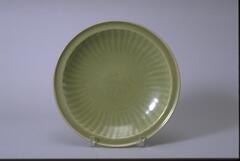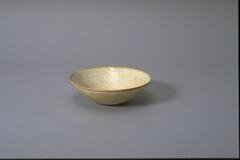Cabinet P: Shelf 3
Celadon Wares in Asia
Although Celadon is the term for a translucent crackle glaze applied to porcelain and stoneware, it has come to mean wares that are specifically greenish blue or gray in color, particularly those from China and Korea. The trademark greenish hues of celadon wares were achieved through the use of clays and glazes that contained small amounts of iron, which turns green in a reduction firing atmosphere. (When there is insufficient oxygen in the air in a kiln, oxygen molecules are pulled from the ceramics themselves; it is this change in chemical composition that changes the color of the ware.) The thickness of the glaze and type of clay determine the color after firing, and getting the “right” effect is extremely difficult. The thin watery glaze runs off high points in the design and pools in impressions, creating dazzling gradations in color, especially in incised and molded designs.
Jade was prized in East Asia, and the ability to imitate its color in porcelain was highly valued. In the Goryeo Period (918-1392) in Korea, a celadon ewer or teacup was more precious than gold or silver. The high estimation of celadon was not limited to Korea, but extended to discerning connoisseurs at the court of the Northern Song dynasty (960–1127) in China. Celadon was quite popular in Japan as well, where it was both imported and manufactured in a native version. Celadon is considered by many to have reached its height during the Goryeo period, and these wares continue to be prized by collectors today.
Created For
K-12 EducatorK-12 Student
Museum Visitor
UMMA Docent
UMMA Staff
University Faculty
University Student
Rate this Resource
AVG: 0 | Ratings: 0
& Author Notes
Creative Commons by-nc-saLast Updated
June 8, 2020 1:09 p.m.Report
Reporting Policy


![<p>This octagonal dish is inlaid with a chrysanthemum design with white and black slip on each facet. Its outer base is entirely glazed and has three quartzite spur marks. The inner surface is undecorated but covered in crackles, revealing the gray body. The glaze was oxidized during ring, leaving many areas brown.<br />
[<em>Korean Collection, University of Michigan Museum of Art </em>(2014) p.117]<br />
</p>
<p>This octagonal dish is inlaid with a chrysanthemum design with white and black slip on each facet. Its outer base is entirely glazed and has three quartzite spur marks. The inner surface is undecorated but covered in crackles, revealing the gray body. The glaze was oxidized during ring, leaving many areas brown.<br />
[<em>Korean Collection, University of Michigan Museum of Art </em>(2014) p.117]<br />
</p>](/media/W1siZiIsIjIwMjIvMDkvMjQvNHVpbG92a2E1bl9kZWZhdWx0LmpwZyJdLFsicCIsInRodW1iIiwiMjQweDIwMCJdXQ?sha=811709a388c3f99f)
![It consists of three parts : a cup stand with perforated base, a gentle curved wing and everted foot. The edges of the wing and the cup stand are decorated with fret designs.<br />
<p>This is a round cup stand, a typical form of 12th century Goryeo celadon. The tray of the stand is incised with three chrysanthemum patterns, and encircling the rim is a fret pattern. The entirely glazed foot retains refractory spur marks. This is a defected product, the rim and foot of which have become warped during firing. The glaze is partially oxidized, giving the saucer a brown hue, but it was produced as a high-grade object.<br />
[<em>Korean Collection, University of Michigan Museum of Art </em>(2014) p.126]</p>
It consists of three parts : a cup stand with perforated base, a gentle curved wing and everted foot. The edges of the wing and the cup stand are decorated with fret designs.<br />
<p>This is a round cup stand, a typical form of 12th century Goryeo celadon. The tray of the stand is incised with three chrysanthemum patterns, and encircling the rim is a fret pattern. The entirely glazed foot retains refractory spur marks. This is a defected product, the rim and foot of which have become warped during firing. The glaze is partially oxidized, giving the saucer a brown hue, but it was produced as a high-grade object.<br />
[<em>Korean Collection, University of Michigan Museum of Art </em>(2014) p.126]</p>](/media/W1siZiIsIjIwMjIvMDUvMjUvNWpmemJ6cG9tYl9kZWZhdWx0LmpwZyJdLFsicCIsInRodW1iIiwiMjQweDIwMCJdXQ?sha=ffdf51947d61a825)
![<p>The bowl has a low, narrow foot, and diagonally aring out sides. It is decorated with raised designs on the inner wall, but they are so low relief that it is di cult to recognize what they are. The outer base retains three quartzite spur marks. Damage to a side of the mouth rim and the center of the bowl has been repaired.<br />
[<em>Korean Collection, University of Michigan Museum of Art </em>(2014) p.99]</p>
It flares out widely at the rim, then back in. Its sides, otherwise almost straight, taper to the base. There is no decorated. <p>The bowl has a low, narrow foot, and diagonally aring out sides. It is decorated with raised designs on the inner wall, but they are so low relief that it is di cult to recognize what they are. The outer base retains three quartzite spur marks. Damage to a side of the mouth rim and the center of the bowl has been repaired.<br />
[<em>Korean Collection, University of Michigan Museum of Art </em>(2014) p.99]</p>
It flares out widely at the rim, then back in. Its sides, otherwise almost straight, taper to the base. There is no decorated.](/media/W1siZiIsIjIwMjIvMDUvMjUvN2U2NG9zYmNkcV9kZWZhdWx0LmpwZyJdLFsicCIsInRodW1iIiwiMjQweDIwMCJdXQ?sha=ae9f35d738cbac9f)
![<p>This dish with a lobed rim was shaped with a mold. Inlaid on each lobed wall and at the center of its inner base with white slip are chrysanthemum spray design and a chrysanthemum floret, respectively. On the flat outer base remain three quartzite spur marks. The entire dish was glazed including the outer base; the state of sintering is good, while the glaze is pure and green. Crackles are spread throughout the inner and outer surfaces.<br />
[Korean Collection, University of Michigan Museum of Art (2014) p.116]</p>
<p>This dish with a lobed rim was shaped with a mold. Inlaid on each lobed wall and at the center of its inner base with white slip are chrysanthemum spray design and a chrysanthemum floret, respectively. On the flat outer base remain three quartzite spur marks. The entire dish was glazed including the outer base; the state of sintering is good, while the glaze is pure and green. Crackles are spread throughout the inner and outer surfaces.<br />
[Korean Collection, University of Michigan Museum of Art (2014) p.116]</p>](/media/W1siZiIsIjIwMjIvMDkvMjQvNGE2MWgzanBral9kZWZhdWx0LmpwZyJdLFsicCIsInRodW1iIiwiMjQweDIwMCJdXQ?sha=59566b92c81b187c)
![<p>This type of bowl was extensively produced throughout the 12th century. The outer wall is decorated with incised and raised deisgn of a two-tiered lotus petal. The glaze was oxidized, producing yellow-green color, but the application of glaze to the entire foot and the use of quartzite spurs indicate that this was produced as a high-quality item.<br />
[<em>Korean Collection, University of Michigan Museum of Art</em> (2014) p.103]</p>
It has a wall gently curving from the mouth toward the bottom before angeling in sharply close to the foot. There is a lotus petal on exterior. The color is brown. <p>This type of bowl was extensively produced throughout the 12th century. The outer wall is decorated with incised and raised deisgn of a two-tiered lotus petal. The glaze was oxidized, producing yellow-green color, but the application of glaze to the entire foot and the use of quartzite spurs indicate that this was produced as a high-quality item.<br />
[<em>Korean Collection, University of Michigan Museum of Art</em> (2014) p.103]</p>
It has a wall gently curving from the mouth toward the bottom before angeling in sharply close to the foot. There is a lotus petal on exterior. The color is brown.](/media/W1siZiIsIjIwMjIvMDUvMjUvMTBnN25oa2prcF9kZWZhdWx0LmpwZyJdLFsicCIsInRodW1iIiwiMjQweDIwMCJdXQ?sha=225012457d334d64)
![<p>This is an undecorated bowl with diagonally flaring out sides. On the outer base and rim of the foot remain traces of refractory spur marks. The bowl was oxidized in the kiln, producing a green-brown hue, while the interior contains large bubbles. The color of its glaze is similar to that of other vessels excavated from sedimentary layers of refuse pile at celadon kilns in Goyang-si, Gyeonggi-do.<br />
[<em>Korean Collection, University of Michigan Museum of Art </em>(2014) p.101]</p>
<br />
It has an outwardly flared rim and steep side. A yellow brownish glaze is applied. The clay contains some impurities and the foot is relatively high. There is four spur-marks on the interior. <p>This is an undecorated bowl with diagonally flaring out sides. On the outer base and rim of the foot remain traces of refractory spur marks. The bowl was oxidized in the kiln, producing a green-brown hue, while the interior contains large bubbles. The color of its glaze is similar to that of other vessels excavated from sedimentary layers of refuse pile at celadon kilns in Goyang-si, Gyeonggi-do.<br />
[<em>Korean Collection, University of Michigan Museum of Art </em>(2014) p.101]</p>
<br />
It has an outwardly flared rim and steep side. A yellow brownish glaze is applied. The clay contains some impurities and the foot is relatively high. There is four spur-marks on the interior.](/media/W1siZiIsIjIwMjIvMDUvMjUvMnhtbDducjBocl9kZWZhdWx0LmpwZyJdLFsicCIsInRodW1iIiwiMjQweDIwMCJdXQ?sha=ab0ce1dba1be4d21)
